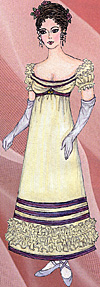"Sweet hearting matches are very often made up at these parties. It's quite disgusting to a modest eye to see the way the young ladies dress to attract the notice of the gentlemen. They are nearly naked to the waist, only just a little bit of dress hanging on the shoulder, the breasts are quite exposed except a little bit coming up to hide the nipples." William Taylor, 1837
|
Plate A: Early Empire gown
White remained an extremely popular color well into the Empire. Though plain classical dresses were definitely in vogue, women's clothing became increasingly decorative, featuring sheer overdresses, bows, frills, embroidery, higher collars and a variety of other ornaments. Shawls were an integral and practical part of fashionable attire. Bonnets and long gloves were required for wear out of doors. Unlike our own era, there was no emphasis on color coordinating accessories, and some color combinations shown in paintings and fashion plates may strike the modern observer as unusual.  |
Plate B: Early to mid-Empire long sleeved gown
By 1806, gowns with trains were less common for everyday wear, but numerous paintings still depicted flowing, trailing skirts. Long sleeves and fur boas, as well as shawls, were common features of ensembles for colder weather. Bonnets features brims in a variety of sizes, which would have protected the complexion.  |
|
Plate C: Late Empire ball gown
By the end of the Napoleonic era, skirts had become slightly flared and shorter, especially on ball gowns. They were usually decorated with rows of ruffles or pleats. Artificial flowers, worn in the hair or attached to gowns became popular accessories.  |
French evening dress, 1817
In the Empire period, attention migrated to the bust as the waistline rose to under-bust level. the body was conceived of as a graceful neo-classical column like that of contemporary architecture, with articulation at the bust equivalent to a capital. Sheer textiles affording some transparency suggest the natural body beneath. [Photo from exhibition "Bare Witness: Clothing and Nudity" at the Costume Institute of The Metropolitan Museum of Art in New York City, reproduced with the permission of Richard Martin, Curator.]  |
Color Plates:
Back to Part 3: Temperance Follows Excess
The Other Installments:
Back to Table of Contents -- Napoleon #6
© Copyright 1996 by Emperor's Press.
This article appears in MagWeb (Magazine Web) on the Internet World Wide Web.
The full text and graphics from other military history magazines and gaming magazines are available at http://www.magweb.com